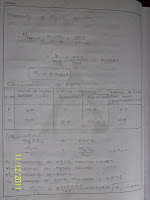AIM : To observe the charge up and decay of the voltage across a capacitor.
To measure the time constant of an RC circuit.
APPARATUS: Regulated DC power supply, capacitors & resistors of large value,multimeter,stop clock, CRO,
circuit breadboard and cable.
INTRO:
RC circuits are used extensively in electronics in blinking lights,setting oscillator frequencies, adjusting delays etc.
A capacitor is a device which can store electrical charge.
A simple parallel plate capacitor consists of two parallel metals plates separated by an insulator like dry air,plastic or ceramic etc.
When we connect a capacitor to a battery, opposite charges are developed on it's plates. this results in a net electric potential which is opposite in direction to that of the battery. now as the capacitor accumilates more and more charge it's said to be charging.as the charge increases the voltage between the two plates also increases which results in a reverse voltage.and when this is exactly equal to the battery voltage, no current flows through the circuit.
now, once the capacitor is charged up, if we disconnect it, some charge still remains on the plates which is discharged when we reconnect it to a bulb which glows as the capacitor gets discharged.
here, the speed with which the discharge takes place is dependent on resistance of the circuit and the capacitance of the capacitor.
this is basic principle involved in measuring the time constant of an R-C circuit.
The value of Time constant is equal to the product of resistance and capacitance
The Circuit diagram is as follows :
Time constant of a capacitor charging circuit is the time required by the voltage across the capacitor to reach to 63.2% of the supply voltage or the charging current to reach 36.8% of the initial value of charging current.
initially when the switch is off, no current is flowing, when switch is on, the capacitor will begin to charge up and voltage will increase.here the voltage is built up across the resistor by ohms law, V = IR
as the charge on the capacitor increases, the current will decrease after reaching a maximum with a certain time constant T.
The voltage across the capacitor is given by the equation
Vc (t) = Vo[1-exp(-t/RC)]
VR(t) = Voexp(-t/RC) or I = (V/R)exp(-t/RC)
But Vo = Vc + Vr
Also,
Vc(t=RC) = Vo[1-exp(-1)]
Vc = 0.63Vo
similarly for charge is given, and then since q = it, we calculate the total current by differentiating Q wrt t
at t= RC, we have i = 0.3681Im
| S.No | Time in seconds (t) | voltage across capacitor using multimeter(Vc) | |
| charging | discharging | ||
| | | | |
| | | | |
| | | | |
| | | | |
Result:
charging T =
Discharging T=
























